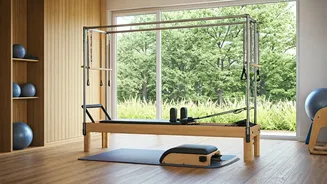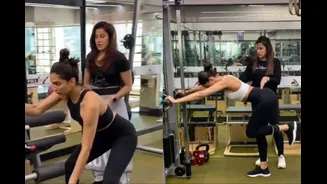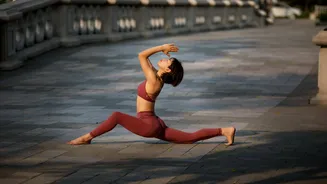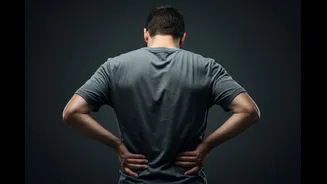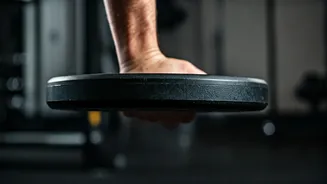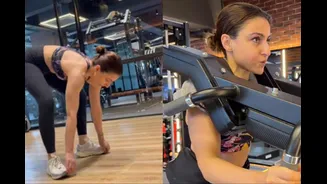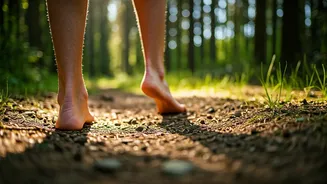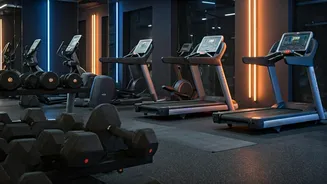Pilates: What's the deal?
Pilates is a form of exercise that emphasizes core strength, flexibility, and body awareness. Created by Joseph Pilates in the early 20th century, it initially
aimed to rehabilitate wounded soldiers. Unlike gym workouts, which often focus on isolating muscle groups, Pilates aims for a more integrated, whole-body approach. This method involves a series of controlled movements performed on a mat or specialized equipment. It centers on the deep core muscles, promoting better posture, balance, and overall physical performance. Pilates emphasizes mindful movement and precise execution, ensuring that each exercise is performed correctly to maximize benefits and minimize the risk of injury. This focus on control and precision distinguishes Pilates from many other forms of exercise, making it a beneficial option for a wide range of individuals.
Boost Core Strength
One of the most significant benefits of Pilates is strengthening the core muscles. The core, encompassing muscles in the abdomen, lower back, and pelvis, is the body's center of power and stability. Unlike gym exercises that might target core muscles indirectly, Pilates directly engages these muscles with every movement. Exercises like the Hundred, Roll Up, and Plank variations are specifically designed to challenge and strengthen the core. Strong core muscles support better posture, reduce the risk of back pain, and improve overall balance and coordination. Whether you're aiming to improve athletic performance or enhance daily activities, a stronger core is essential. Through consistent Pilates practice, individuals can develop a robust and resilient core, leading to a host of health benefits.
Improved Flexibility
Pilates is exceptional at improving flexibility. Many exercises incorporate stretching and lengthening movements that enhance the range of motion in joints and muscles. While walking offers some movement, it doesn't usually provide the same level of targeted flexibility training. In contrast, Pilates includes exercises such as the Spine Stretch Forward, Swan Dive, and Side Bend, all designed to increase flexibility. Increased flexibility reduces muscle stiffness and the risk of injury. Enhanced flexibility also supports better posture, making everyday activities easier and more comfortable. Regular Pilates practice can lead to a more supple and mobile body, increasing overall physical well-being. This focus on improving flexibility makes Pilates a well-rounded exercise choice.
Enhanced Body Awareness
Pilates emphasizes body awareness, promoting a strong mind-body connection. Each movement is performed consciously, with attention paid to posture, breathing, and muscle engagement. Unlike gym workouts, which can sometimes lead to rushed movements, Pilates encourages participants to slow down and focus on precision. This mindful approach helps individuals develop a greater understanding of their bodies and how they move. Pilates instructors often cue participants to focus on specific muscle groups, alignment, and breathing patterns. Practicing Pilates helps with detecting and correcting imbalances, preventing injuries, and improving overall movement efficiency. Increased body awareness can lead to better posture, reduced strain on joints, and enhanced overall physical control. This aspect of Pilates makes it a great method for those who want to be more mindful.
Better Posture and Balance
Pilates is incredibly effective at improving posture and balance. The focus on core strength and body awareness directly translates into enhanced postural alignment. Pilates exercises, such as the Shoulder Bridge and Teaser, engage the muscles that support the spine, leading to a more upright and balanced stance. This also improves balance by strengthening the core muscles that stabilize the body and promote coordination. Better posture reduces strain on the spine, neck, and shoulders. Improved balance minimizes the risk of falls and enhances overall physical confidence. Regular Pilates sessions help reinforce proper alignment, supporting a more stable and graceful posture. Whether at the gym, walking, or during daily tasks, you will find Pilates can help you move much better.
Convenience and Accessibility
Pilates offers significant advantages in convenience and accessibility over gym workouts. Many Pilates exercises can be performed at home with minimal equipment, such as a mat. This convenience eliminates the need to travel to a gym or fitness studio, saving time and money. While walking is also accessible, Pilates offers a structured, targeted approach that can be easily adapted to different fitness levels and needs. There are numerous online resources, including videos and tutorials, making Pilates accessible to anyone with an internet connection. Pilates is a low-impact exercise suitable for all ages and fitness levels, reducing the risk of injuries. Its adaptability makes it ideal for anyone seeking a flexible and effective workout routine that they can do at home.
